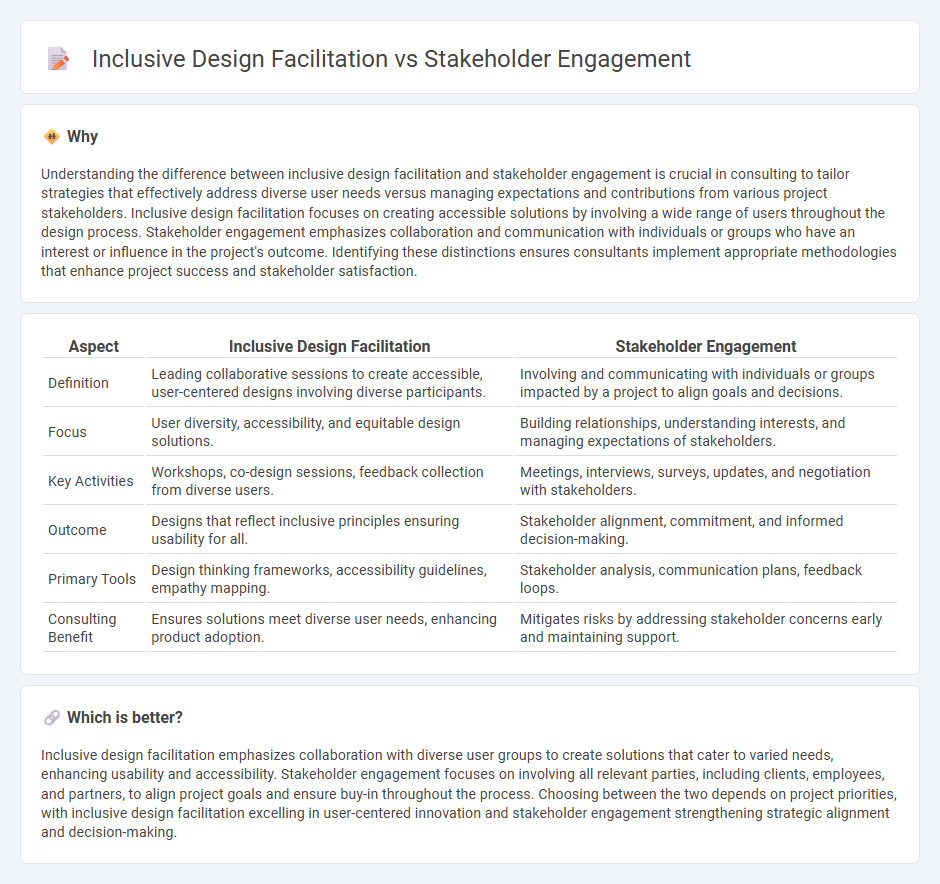
Inclusive design facilitation ensures diverse perspectives actively shape project outcomes by prioritizing accessibility and equitable participation, while stakeholder engagement focuses on aligning interests and securing buy-in from key parties throughout the process. Both approaches drive collaboration, but inclusive design emphasizes user-centered co-creation that addresses varied needs more comprehensively. Explore how integrating these methods enhances consulting effectiveness and fosters innovation.
Why it is important
Understanding the difference between inclusive design facilitation and stakeholder engagement is crucial in consulting to tailor strategies that effectively address diverse user needs versus managing expectations and contributions from various project stakeholders. Inclusive design facilitation focuses on creating accessible solutions by involving a wide range of users throughout the design process. Stakeholder engagement emphasizes collaboration and communication with individuals or groups who have an interest or influence in the project's outcome. Identifying these distinctions ensures consultants implement appropriate methodologies that enhance project success and stakeholder satisfaction.
Comparison Table
| Aspect | Inclusive Design Facilitation | Stakeholder Engagement |
|---|---|---|
| Definition | Leading collaborative sessions to create accessible, user-centered designs involving diverse participants. | Involving and communicating with individuals or groups impacted by a project to align goals and decisions. |
| Focus | User diversity, accessibility, and equitable design solutions. | Building relationships, understanding interests, and managing expectations of stakeholders. |
| Key Activities | Workshops, co-design sessions, feedback collection from diverse users. | Meetings, interviews, surveys, updates, and negotiation with stakeholders. |
| Outcome | Designs that reflect inclusive principles ensuring usability for all. | Stakeholder alignment, commitment, and informed decision-making. |
| Primary Tools | Design thinking frameworks, accessibility guidelines, empathy mapping. | Stakeholder analysis, communication plans, feedback loops. |
| Consulting Benefit | Ensures solutions meet diverse user needs, enhancing product adoption. | Mitigates risks by addressing stakeholder concerns early and maintaining support. |
Which is better?
Inclusive design facilitation emphasizes collaboration with diverse user groups to create solutions that cater to varied needs, enhancing usability and accessibility. Stakeholder engagement focuses on involving all relevant parties, including clients, employees, and partners, to align project goals and ensure buy-in throughout the process. Choosing between the two depends on project priorities, with inclusive design facilitation excelling in user-centered innovation and stakeholder engagement strengthening strategic alignment and decision-making.
Connection
Inclusive design facilitation and stakeholder engagement are interconnected through their focus on collaboration and diverse input to create solutions that meet varied user needs. Engaging stakeholders ensures multiple perspectives are considered, enhancing the inclusivity and effectiveness of the design process. This approach promotes mutual understanding and drives innovation by incorporating feedback from all relevant parties.
Key Terms
Communication strategies
Effective communication strategies in stakeholder engagement prioritize transparent dialogue, active listening, and feedback loops to align diverse interests and build trust. Inclusive design facilitation emphasizes empathetic communication, co-creation workshops, and visual aids to ensure all voices, including marginalized groups, are understood and incorporated. Explore more on how tailored communication approaches can bridge gaps between stakeholder engagement and inclusive design facilitation.
Co-creation sessions
Co-creation sessions prioritize stakeholder engagement by actively involving diverse participants to capture a wide range of insights, fostering collaboration among users, designers, and decision-makers. Inclusive design facilitation ensures that these sessions accommodate different abilities and perspectives, removing barriers and promoting equitable participation throughout the design process. Explore effective methods to enhance co-creation through stakeholder engagement and inclusive design facilitation for innovative and user-centered outcomes.
Power dynamics
Power dynamics profoundly influence stakeholder engagement by shaping participation and decision-making authority among diverse groups. Inclusive design facilitation actively mitigates these imbalances, ensuring equitable representation and collaboration throughout the design process. Explore more about strategies to balance power and enhance inclusive outcomes in design projects.
Source and External Links
Stakeholder engagement - Stakeholder engagement is the process by which an organization involves people who may be affected by or can influence its decisions, aiming to give them a genuine say and ensure their contributions shape outcomes.
What is Stakeholder Engagement, and Why is it Important for Strategic Planning? - Stakeholder engagement involves identifying, listening to, collaborating with, and informing stakeholders to align interests, build trust, and support strategic initiatives.
Stakeholder Engagement: What It Means & Why It Matters - Stakeholder engagement is a structured process of communication, relationship-building, and feedback to share information, gain insights, and enhance project outcomes for both organizations and their stakeholders.
 dowidth.com
dowidth.com